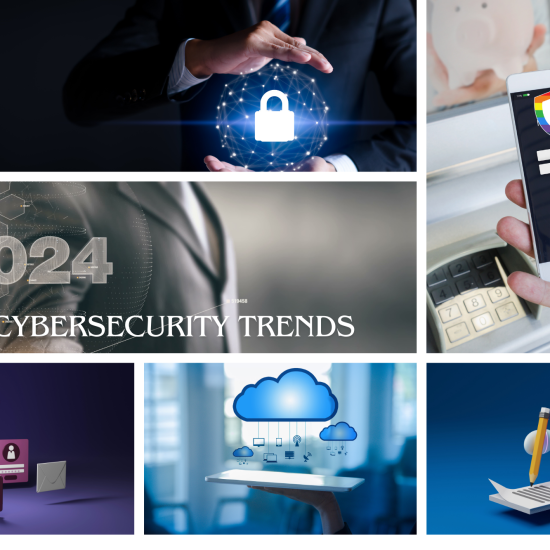Top 10 lessons from cybersecurity attacks in 2023
As we reflect on the events of 2023, one of the prominent themes that has dominated headlines and boardroom discussions alike is the escalating wave of cybersecurity attacks. From high-profile data breaches to ransomware attacks, organizations across the globe have faced unprecedented challenges in safeguarding their digital assets. In the wake of these incidents, several valuable lessons have emerged, shedding light on the evolving landscape of cyber threats and the imperative for proactive cybersecurity measures.
In this article, you will read about prominent cybersecurity attacks in 2023 and what lessons we have learned from them.
Lesson 1: The Perils of Ransomware Attacks
One of the most significant lessons learned in 2023 revolves around the perils of ransomware attacks. The year witnessed an alarming surge in these malicious campaigns, crippling businesses, municipalities, and even critical infrastructure. In some cases, cybercriminals used “double extortion” tactics, exfiltrating sensitive data before encrypting systems and then demanding ransom payments to prevent public release of the stolen data. The importance of robust backup systems, regular data backups, and comprehensive incident response plans became abundantly clear. Organizations learned that investing in cybersecurity isn’t just about prevention but also about having resilient strategies in place to recover swiftly from potential breaches.

Lessons learned:: Organizations should adopt a multi-layered security approach, including regular backups, robust endpoint protection, employee training, and incident response plans to mitigate the risks associated with ransomware attacks. Furthermore, organizations must stay informed of emerging ransomware trends and proactively update their defenses.
Lesson 2: Supply Chain Vulnerabilities
The interconnected nature of modern business ecosystems has exposed organizations to new and complex threats. Cybersecurity attacks targeting supply chains gained prominence in 2023, emphasizing the need for a comprehensive approach to securing the entire network. Throughout 2023, supply chain attacks became prevalent and effective tactics employed by cybercriminals. By targeting vulnerabilities in third-party software or hardware components, attackers infiltrated and compromised the networks of numerous organizations that rely on those products. This trend has emphasized the importance of scrutinizing the security of software supply chains and establishing clear procedures for vetting third-party providers. Companies learned that evaluating the cybersecurity posture of vendors and partners is just as crucial as fortifying their internal defenses. Strengthening supply chain security emerged as a strategic imperative to prevent cascading cyber threats.

Lessons learned:: Organizations must assess the cybersecurity posture of their suppliers, conduct regular audits, and implement strict security policies to minimize the risk of supply chain attacks. Software developers should prioritize security during their development process, incorporating rigorous testing and continuous monitoring for vulnerabilities. Strengthening supply chain security can better protect organizations against threats that exploit weaknesses in third-party components.
Lesson 3: Emphasis on Zero Trust Architecture
The traditional perimeter-based security model proved increasingly inadequate in the face of sophisticated cyber threats. 2023 saw a paradigm shift towards Zero Trust Architecture, a security framework that treats every user and device as potentially untrusted, regardless of their location within the network. Organizations recognized the need to implement continuous authentication, strict access controls, and real-time monitoring to enhance security posture and mitigate lateral movement by attackers.

Lessons learned: Cybersecurity teams have gleaned valuable insights from the implementation of Zero Trust Architecture (ZTA). Zero Trust is not just a technology or a tool; it’s a security framework that mandates trust verification for anyone and anything trying to access resources on a network, regardless of their location. The lessons learned by cybersecurity teams in implementing Zero Trust Architecture revolve around the principles of continuous verification, micro-segmentation, data-centric security, visibility, and user education. These lessons contribute to a more adaptive and resilient security posture in an increasingly complex and evolving threat landscape.
Lesson 4: Collaboration and Information Sharing
The year 2023 highlighted the importance of collaboration and information sharing within the cybersecurity community. Facing a common adversary in cybercriminals, organizations, government agencies, and cybersecurity professionals realized the need to pool resources, intelligence, and expertise. Threat intelligence sharing platforms and industry-specific alliances became instrumental in proactively identifying and mitigating emerging threats.

Lessons learned: By sharing threat intelligence, indicators of compromise (IoCs), and attack patterns, cybersecurity teams can collectively respond more quickly to new and evolving cyber threats, minimizing potential damage. Shared threat intelligence allows organizations to adapt and fortify their defenses based on a broader understanding of the threat landscape. In the event of a cyber incident, timely and effective collaboration enables a faster and more efficient response. Coordinated efforts often lead to quicker recovery and reduced financial and reputational damage. Fostering partnerships with government agencies, law enforcement, and other private organizations enhances the collective ability to tackle cyber threats on a larger scale, creating a more robust defense ecosystem.
Lesson 5: The Growing Threat of Insider Attacks
A number of high-profile insider attacks in 2023 demonstrated that even the most secure organizations can fall victim to breaches caused by malicious or negligent employees. These incidents exposed sensitive information, damaged reputations, and resulted in significant financial losses. Some attacks were financially motivated, while others were driven by disgruntled employees seeking revenge or espionage.

Lessons learned: Organizations must implement comprehensive insider threat programs, which include employee monitoring, access controls, and ongoing security awareness training to minimize the risk of insider attacks. Regularly reviewing and updating access privileges, as well as implementing zero-trust policies, can further reduce the potential impact of insider threats.
Lesson 6: AI-Powered Cyberattacks
The use of artificial intelligence and machine learning in cyberattacks has become increasingly prevalent in 2023, with attackers leveraging these technologies to automate reconnaissance, exploit discovery, and attack execution. The rapid evolution of AI-driven cyberattacks has made it more challenging for security professionals to keep up with and defend against emerging threats.

Lessons learned: Organizations need to invest in AI-powered cybersecurity tools and solutions to detect, prevent, and respond to AI-driven cyberattacks effectively. AI-powered attacks demonstrate a higher level of sophistication and speed compared to traditional cyber threats. Adversaries can leverage machine learning algorithms to analyze vast amounts of data quickly, adapting their tactics in real-time. Cybersecurity defenses must also evolve to keep pace with these advancements. AI-powered attacks may not be limited to traditional IT systems. They could extend to operational technology (OT) and Internet of Things (IoT) devices. Organizations should adopt a holistic approach to cybersecurity that includes securing interconnected systems.
Lesson 7: The Intersection of Geopolitics and Cybersecurity
2023 witnessed a surge in state-sponsored cyberattacks, with geopolitical tensions spilling over into cyberspace. These attacks, often targeting critical infrastructure, have emphasized the need for international cooperation and diplomacy in the realm of cybersecurity. Nation-state actors have been implicated in multiple incidents, aiming to destabilize economies, manipulate public opinion, and steal valuable intellectual property. As a result, cybersecurity has become a critical component of national security strategies.

Lessons learned: Governments and organizations should collaborate on sharing threat intelligence, developing cybersecurity norms, and fostering dialogue to address the challenges posed by state-sponsored cyber threats. Establishing international agreements and cooperative frameworks can help deter malicious activities, facilitate the attribution of attacks, and hold nation-state actors accountable for their actions in cyberspace. By working together, the global community can build a more secure and resilient digital landscape that can withstand the geopolitical pressures and challenges.
Lesson 8: The Increasing Importance of Data Privacy and Compliance
As the number of high-profile data breaches and privacy violations continued to grow in 2023, regulatory bodies around the world have stepped up their efforts to enforce data protection laws and regulations. This increased scrutiny has led to significant fines for non-compliant organizations and has highlighted the need for businesses to prioritize data privacy and compliance in their cybersecurity strategies.

Lessons learned: Organizations must recognize that data is a valuable asset and treat it as such. This includes implementing robust security measures to protect sensitive information. Organizations must familiarize themselves with the relevant data protection regulations in their industry and jurisdiction, implementing robust data privacy practices, and ensuring compliance. Adhering to data protection regulations is not just a legal requirement but also a key cybersecurity practice. Compliance with laws such as GDPR, HIPAA, or others is crucial for safeguarding user privacy. This includes conducting regular privacy risk assessments, establishing clear data handling policies, and training employees on data protection best practices. By prioritizing data privacy and compliance, organizations can minimize the risk of legal penalties and reputational damage resulting from data breaches or privacy violations. Organizations should prioritize transparency with users about how their data is collected, processed, and used. Obtaining clear and informed consent is fundamental to building trust. Implementing continuous monitoring and auditing processes helps identify and respond to potential security incidents promptly. Regular assessments ensure that security measures remain effective and up-to-date.
Lesson 9: The Critical Role of Cybersecurity Awareness and Training
In 2023, a significant number of cyberattacks were successful due to human error or negligence. This highlights the importance of cybersecurity awareness and training for employees at all levels of an organization. Cybercriminals often exploit employees’ lack of awareness through phishing campaigns, social engineering attacks, or other deceptive tactics, which can lead to compromised credentials, unauthorized access, or the inadvertent disclosure of sensitive information.

Lessons learned: Organizations must invest in comprehensive cybersecurity awareness programs to educate their employees on the latest cyber threats, best practices for safe online behavior, and the organization’s security policies. Human errors, such as falling for phishing attacks or using weak passwords, can lead to security breaches. Investing in awareness and training helps mitigate this risk. Phishing attacks remain a prevalent and effective method for cybercriminals. Training programs should educate employees on how to recognize phishing attempts, avoid clicking on suspicious links, and report potential threats. Regular and up-to-date training sessions ensure that employees are equipped to handle the latest tactics and techniques employed by cybercriminals. Conducting simulated phishing attacks and other security exercises provides a practical experience for employees. This helps them understand the real-world implications of cyber threats and enhances their ability to respond effectively. Cybersecurity awareness is not just for front-line employees; executives and leaders need to be well-versed in cybersecurity best practices. Their commitment and support are vital for creating a security-conscious organizational culture. Cyber threats evolve, and so should cybersecurity training.
Lesson 10: The Need for Proactive Threat Hunting and Incident Response
As cyber threats continue to evolve and become more sophisticated, organizations must shift their focus from reactive security measures to proactive threat hunting and incident response. In 2023, several organizations that were able to detect and respond to cyberattacks quickly managed to minimize the damage and disruption caused by the incidents.

Lessons learned: Organizations should develop and maintain a proactive threat hunting program, which involves actively searching for signs of compromise within their networks and systems. By regularly monitoring for anomalies and investigating potential threats, organizations can identify and remediate security breaches before they escalate. Additionally, having a well-defined incident response plan in place can ensure that organizations are prepared to act swiftly and decisively in the event of a cyberattack, minimizing the overall impact on the organization’s operations, reputation, and bottom line.
The cybersecurity landscape of 2023 has left an indelible mark on organizations worldwide. From the rise of ransomware attacks to the imperative of continuous cybersecurity training, the lessons learned are invaluable for shaping future strategies. As we move forward, the key lies in adopting a proactive mindset, staying informed about emerging threats, and fostering a culture of cybersecurity resilience. The evolving nature of cyber threats demands constant adaptation, and the lessons learned in 2023 serve as a foundation for building a more secure digital future.
Rainbow Secure plays a pivotal role in fortifying your business against cyber threats. In an era where digital security is no longer optional but a necessity, Rainbow Secure stands as a guardian, offering robust, user-friendly, and compliant security solutions.
Enhanced Security Rainbow Secure’s multi-dimensional approach to security, incorporating unique color and style-based authentication, has redefined the meaning of ‘secure login’. By protecting against threats like keyloggers, brute force, and phishing attacks, we ensure that critical infrastructure sector can operate in the digital realm with confidence and peace of mind.
Simplified User Experience Understanding that complexity is the enemy of security, Rainbow Secure has revolutionized the user experience. Our intuitive and customizable login process not only enhances security but also fosters user engagement and compliance. This ease of use is critical in ensuring that security measures are consistently and effectively implemented across organizations.
Compliance and Regulation In today’s regulatory landscape, compliance is not just about checking boxes. It’s about protecting reputations, building trust, and ensuring long-term sustainability. Rainbow Secure helps critical infrastructure sector navigate this complex terrain, adhering to stringent standards like GDPR, HIPAA, and NIST, among others. Our commitment to compliance is a testament to our dedication to not just meeting, but exceeding, the highest standards of data protection and privacy.
How can Rainbow Secure help?
Right amount of data and system access to right person or role at right time is the key to organizations being able to use digital tools and platforms to serve the customer base and stay compliant.
Next Generation Rainbow Secure platform is a modern identity authentication (MFA) and single sign- on (SSO) solution for your business across on-premises and cloud environments. It’s backed by an experienced team of cloud and security experts, years of innovation, and partnerships with leading cloud platforms. Rainbow Secure is a Leader in Smart and Secure Digital Solutions that work for you.
Insider Threats: Rainbow Secure assists in mitigating insider threats by implementing access controls, user monitoring, and privilege management solutions. Also, if the user leaves behind unlocked devices, saved passwords in the password manager or browser can be misused by malicious insiders. Interactive login security from Rainbow Secure helps prevents unauthorized access and protects against data theft or misuse by privileged users.
ChatGPT Security for business: Secure your ChatGPT login and Data with Rainbow Secure MFA Plugin.
Secure AI Integration: Consult Rainbow Secure Team to integrate AI in your business workflows powered by Azure and Rainbow Secure API.
Secure Workforce & Customer login: Use Authentication Plug-in by Rainbow Secure to secure workforce and customer logins. In this plug-in, you get a multi-dimensional password, passwordless login solutions with AI monitoring, Risk Analytics, and location fencing.
IoT Friendly Security: IoT platform developers can secure their cloud endpoints, and user logins (both admin and customer) against unauthorized access and scripted malware attacks using easy to adapt and support multi-layer interactive rainbow secure authentication solutions and services that includes but not limited to security assessment, API Security, secure user onboarding, and risk analytics.
Secure Data and its Backups We provide Cloud based data vault and data archive solutions backed by Microsoft Azure and secured by our authentication plugin and industry best practices to give you ransomware protection, help with data governance and disaster mitigation.
Database Security We provide technical consulting services to Secure Databases in cloud and on premise. You get best protection for your data in databases using native and third-party security tools.
Meet Compliance Requirements: Use Authentication Plug-in by Rainbow Secure with your business application and in SSO (Single Sign-on) and meet industry standards and compliance regulations such as NIST, ISO, FTC, SOX, SOC2, CMMC, CMMI, HIPAA, PCI, and others.
Securely communicate and Collaborate: Use Secure Business Email by Rainbow Secure and get protection against account takeover, phishing, ransomware, and automated login cyber frauds. In this email, you get options to send encrypted emails, single sign-on with Office 365, and Google, and 1 TB one drive storage.
Connect Business applications: Get one unified login using Rainbow Secure Single Sign-On
Manage User Onboarding / Offboarding using Rainbow Secure IAM
Verify User using Smart Multi-factor MFA. Smart Multi-Factor Authentication from Rainbow Secure which adjusts to your use case, reduces the cyber liabilities of a business from stolen credentials and improves productivity, and enhances user experience.
Do you have more questions about how Rainbow Secure innovative solutions help to enhance your security posture and safeguard your business from cyber threats and attacks? Contact us today. Email us at Hello@rainbowsecure.com







